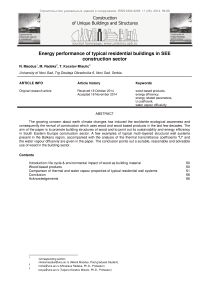Энергетические характеристики типичных жилых домов в строительном секторе
Автор: Маодус Никола, Радека Мирослава, Кочетов Мишулич Татьяна
Журнал: Строительство уникальных зданий и сооружений @unistroy
Рубрика: Энергоэффективность и энергосбережение
Статья в выпуске: 11 (26), 2014 года.
Бесплатный доступ
Растущая обеспокоенность по поводу изменения климата на планете побудило мировое экологическое сознание возродить производство строительных конструкций на основе древесины. В статье анализируется эффективность использования конструкций из дерева и на основе древесины в строительной отрасли в Юго-Восточной Европе. Несколько примеров типичных слоистых несущих конструкций, характерных для региона Балкан рассматриваются с анализом их теплопроводности и диффузии водяного пара. Выводы подтверждают эффективность использования древесины и конструкций на ее основе в строительном секторе.
Продукты на основе из дерева, энергоэффективность, энергетические параметры, коэффициент u, диффузии водяного пара
Короткий адрес: https://sciup.org/14322062
IDR: 14322062
Список литературы Энергетические характеристики типичных жилых домов в строительном секторе
- Directive 2010/31/EU on energy performance of buildings, OJEU 18.6.2010, 23 p.
- Regulation (EU) No 305/2011 on Construction Products, OJEU 4.4.2011, 39 p.
- Requirements on Energy Efficiency in Buildings, OJ RS, no. 61/2011, 46 p.
- SRPS EN ISO 13788: Hygrothermal performance of building components and building elements-Internal surface temperature to avoid critical surface humidity and interstitial condensation-Calculation methods, ISS Belgrade, 2008., 38p.
- SRPS EN 1745: Masonry and masonry products-methods for determining design thermal values, ISS Belgrade, 2009, 52 p.
- Buxbaum C., Seiler A., Pankratz O. Hygrothermal performance of passive house wall systems -simulation and monitoring, 11th Canadian Conference on Building Science and Technology, Banff, Alberta, 2007. Pp. 11-22.
- YTONG Ž system URL: http://www.ytong.rs/rs/docs/130319_YTONG_Katalog_proizvoda_2013.pdf (date of reference 10.09.2014)
- URL: http://www.dataholz.com/(date of reference 10.09.2014)
- BS EN 13986: Wood-based panels for use in construction -Characteristics, evaluation of conformity and marking, BSi, London, 60 p.
- Hens H. Performance Based Building Design1, From Below Grade Construction to Cavity Walls, Wilhelm Ernst & Sohn, 2002, Germany, 274 p.
- Cointe A., Castéra P., Morlier P., Galimard P. Diagnosis and monitoring of timber buildings of cultural heritage, Structural Safety. Vol.29 (4), 2007, Pp. 337-348.
- Morrell J. J. Wood-based building components: what have we learned? (2002) International Biodeterioration & Biodegradation, Vol. 49(4) Biodet.of Constr. Materials. Pp. 253-258.
- Blom I., Itard L., Meijer A. Environmental impact of dwellings in use: Maintenance of façade components (2010) Building and Environment. Vol. 45. Issue 11. Pp. 2526-2538.
- Haapio A., Viitaniemi P. Environmental effect of structural solutions and building materials to a building//Environmental Impact Assessment Review. 2008. Vol. 28. Issue 8. Pp. 587-600.
- Zelazna A., Pawłowski A. The environmental analysis of insulation materials in the context of sustainable buildings, environmental engineering, in: The 8th International Conference, Vilnius, Lithuania, May 19-20, 2011, Pp. 825-829.
- Ватин Н. И., Горшков А. С., Немова Д. В. Энергоэффективность ограждающих конструкций при капитальном ремонте//Строительство уникальных зданий и сооружений. 2013. №3 (8). С. 1-11.
- Горшков А. С., Немова Д. В., Ватин Н. И. Формула энергоэффективности//Строительство уникальных зданий и сооружений. 2013. №3 (8). С.49-63.
- Горшков А. С., Ватин Н. И., Дацук T. A., Безруков A. Ю., Немова Д.В., Какула П., Виитанен А. Альбом технических решений по применению теплоизоляционных изделий из пенополиуретана в строительстве жилых, общественных и промышленных зданий. АТР -СПУ -02 -14: материалы для проектирования//Строительство уникальных зданий и сооружений. 2014. №5 (20). С. 71-439.
- Murgul, V. Features of energy efficient upgrade of historic buildings (illustrated with the example of Saint-Petersburg) (2014) Journal of Applied Engineering Science, Vol. 12 (1), Pp. 1-10
- Мургул В. Возможности использования солнечной энергии для энергоснабжения жилых зданий исторической застройки Санкт-Петербурга и улучшения качества городской среды//Архитектон: известия вузов. 2012. 4 (40). С. 54-62.
- Pintarič, K., Premrov, M. Mathematical modelling of timber-framed walls using fictive diagonal elements (2013) Applied Mathematical Modelling, 37 (16-17), Pp. 8051-8059.
- Ber, B., Premrov, M., Štrukelj, A., Kuhta, M. Experimental study of timber-glass composite wall elements (2013) COST Action TU0905 Mid-Term Conference on Structural Glass -Proceedings of COST Action TU0905 Mid-Term Conference on Structural Glass, Pp. 253-260.
- Žegarac Leskovar, V., Premrov, M., Vidovič, K. Architectural geometry of timber-glass buildings and its impact on energy flows through building skin (2013) COST Action TU0905 Mid-Term Conference on Structural Glass -Proceedings of COST Action TU0905 Mid-Term Conference on Structural Glass, Pp. 133-139.
- Leskovar, V.Ž., Premrov, M. An approach in architectural design of energy-efficient timber buildings with a focus on the optimal glazing size in the south-oriented façade (2011) Energy and Buildings, 43 (12), Pp. 3410-3418.


